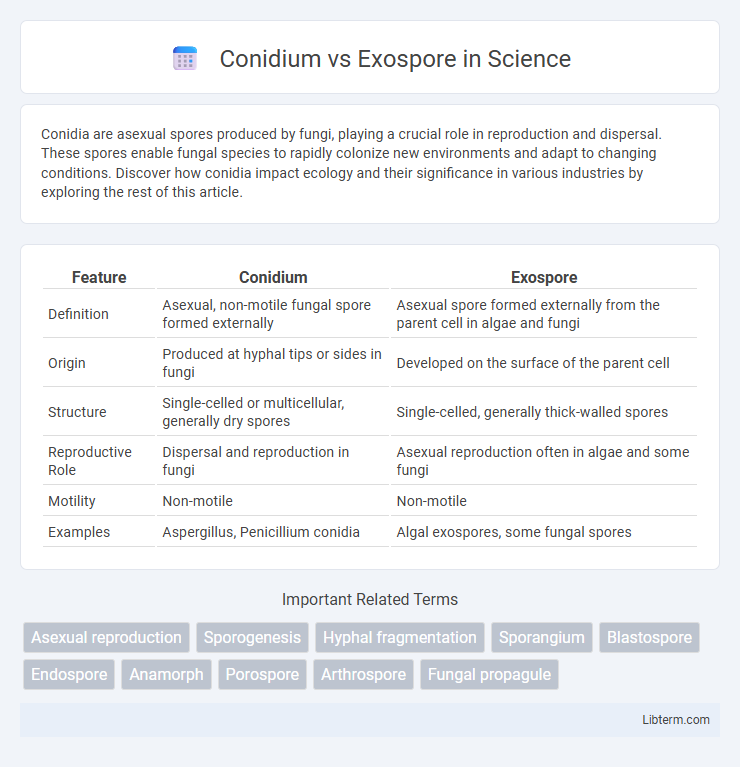Conidia are asexual spores produced by fungi, playing a crucial role in reproduction and dispersal. These spores enable fungal species to rapidly colonize new environments and adapt to changing conditions. Discover how conidia impact ecology and their significance in various industries by exploring the rest of this article.
Table of Comparison
| Feature | Conidium | Exospore |
|---|---|---|
| Definition | Asexual, non-motile fungal spore formed externally | Asexual spore formed externally from the parent cell in algae and fungi |
| Origin | Produced at hyphal tips or sides in fungi | Developed on the surface of the parent cell |
| Structure | Single-celled or multicellular, generally dry spores | Single-celled, generally thick-walled spores |
| Reproductive Role | Dispersal and reproduction in fungi | Asexual reproduction often in algae and some fungi |
| Motility | Non-motile | Non-motile |
| Examples | Aspergillus, Penicillium conidia | Algal exospores, some fungal spores |
Introduction to Fungal Spores
Fungal spores are reproductive structures essential for the dissemination and survival of fungi in diverse environments. Conidia are asexual, non-motile spores produced externally on specialized hyphae called conidiophores, facilitating rapid and widespread fungal propagation. Exospores, less common, are formed by the budding or differentiation of the fungal cell wall and serve as another mode of asexual reproduction, contributing to fungal resilience and adaptation.
Defining Conidia: Structure and Function
Conidia are asexual, non-motile spores produced externally on specialized fungal hyphae called conidiophores, characterized by their diverse shapes and sizes which facilitate efficient dispersal in various environments. These spores serve as reproductive units allowing fungi to propagate rapidly without the need for sexual reproduction, playing a crucial role in fungal colonization and survival. In contrast, exospores are asexual spores formed by the budding of the parent cell's outer wall, typically less specialized in dispersal mechanisms compared to conidia.
Understanding Exospores: Characteristics and Formation
Exospores are a type of asexual spore formed externally on the hyphal tips or cells, characterized by their thick protective walls that enable survival in harsh environmental conditions. Unlike conidia, which are produced by specialized structures called conidiophores, exospores develop by the budding or segmentation of the parent cell, often seen in certain fungi and algae. Their formation and resistance traits make exospores crucial for dispersal and persistence in unfavorable habitats.
Key Differences Between Conidia and Exospores
Conidia are asexual, non-motile spores produced externally on specialized hyphae called conidiophores, primarily found in Ascomycetes and Deuteromycetes fungi, whereas exospores are asexual spores formed by the budding or segmentation of the parent cell's outer wall in certain fungi and algae. Conidia play a crucial role in dispersal and reproduction without fusion, often produced in large numbers for rapid colonization, while exospores generally serve as a survival mechanism under adverse conditions. Unlike exospores, conidia lack a protective thick wall and are typically dispersed by air, enhancing the spread of pathogenic fungi in agricultural environments.
Life Cycle Comparison: Conidium vs Exospore
Conidium and exospore differ significantly in their roles within fungal and algal life cycles, respectively. Conidia are asexual spores produced externally on specialized hyphae, facilitating rapid dispersal and reproduction in fungi under favorable environmental conditions. Exospores form by budding directly from the parent cell's surface in algae, enabling survival through adverse conditions and initiating new growth cycles without sexual recombination.
Morphological Variations of Conidia and Exospores
Conidia exhibit diverse morphological variations including differences in size, shape, septation, and pigmentation, which aid in species identification and adaptation to environmental conditions. Exospores, typically formed within the cell wall and released upon cell lysis, vary less in morphology, often appearing as smooth, non-motile spores with a uniform structure. The distinctive surface texture and septation patterns in conidia contrast with the simpler, enclosed nature of exospores, highlighting their differing roles in fungal reproduction and dispersal.
Ecological Roles and Importance
Conidia serve as asexual spores primarily in fungi, facilitating rapid dispersal and colonization in diverse terrestrial ecosystems, which aids in nutrient cycling and symbiotic relationships. Exospores, produced by certain bacteria and fungi, contribute to survival in harsh environmental conditions by forming resistant structures that ensure species persistence. Both spore types play critical roles in ecosystem dynamics by promoting microbial diversity, population resilience, and the decomposition of organic matter.
Reproductive Strategies in Fungi
Conidia are asexual, non-motile spores produced externally on specialized hyphae called conidiophores, enabling rapid and abundant fungal propagation in favorable conditions. Exospores, formed by the rounding and cleavage of fungal hyphal tips, serve as another asexual reproductive strategy, often providing resilience to environmental stress. Both conidia and exospores facilitate dispersal and colonization, but conidia typically allow for wider distribution due to their lightweight and numerous nature.
Industrial and Medical Relevance
Conidia are asexual spores produced by fungi like Aspergillus and Penicillium, extensively utilized in industrial enzyme production and antibiotic synthesis due to their rapid dispersal and genetic stability. Exospores, formed by certain bacteria and fungi, offer resilience under harsh environmental conditions, making them valuable in biotechnological applications requiring durable microbial formulations. Medically, conidia are significant as airborne vectors of pathogenic fungi causing respiratory infections, whereas exospores are less frequently implicated in human disease but are studied for their robust survival mechanisms.
Conclusion: Conidium vs Exospore
Conidium and exospore represent distinct asexual spore types in fungi and algae, respectively, with conidia formed externally on specialized hyphae and exospores developing directly from the parent cell's outer wall. Conidia typically facilitate rapid dispersal in fungi, enhancing adaptability to environmental changes, whereas exospores serve as resilient survival structures in algae, ensuring persistence under unfavorable conditions. Understanding these differences highlights their evolutionary adaptations for reproduction and survival across diverse ecological niches.
Conidium Infographic

 libterm.com
libterm.com